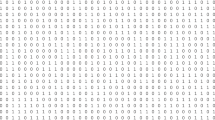Abstract
In this paper, we consider a general construction of doubly-even self-dual codes. From three symmetric 2-(31, 10, 3) designs, we construct at least 3228 inequivalent extremal doubly-even [64, 32, 12] codes. These codes are distinguished by their K-matrices.
Similar content being viewed by others
References
F. C. Bussemarker and V.D. Tonchev, New extremal doubly-even codes of length 56 derived from Hadamard matrices of order 28,Discrete Math., Vol. 76 (1989) pp. 45–49.
F. C. Bussemarker and V. D. Tonchev, Extremal doubly-even codes of length 40 derived from Hadamard matrices of order 20,Discrete Math., Vol. 82 (1990) pp. 317–321.
P. J. Cameron and J. H. van Lint,Graphs, Codes and Designs, Cambridge University Press, Cambridge (1980).
S. N. Kapralov and V. D. Tonchev, Extremal doubly-even codes of length 64 derived from symmetric designs,Discrete Math., Vol. 83 (1990) pp. 285–289.
H. Kimura, Hadamard matrices of order 28 with automorphism groups of order two,J. Combin. Theory, Ser. A, Vol. 43 (1986) pp. 98–102.
H. Kimura, Extremal doubly even (56,28,12) codes and Hadamard matrices of order 28,Australasian J. Combin., Vol. 10 (1994) pp. 153–161.
C. L. Mallows and N. J. A. Sloane, An upper bond for self-dual codes,Inform. Control. Vol. 22 (1973) pp. 188–200.
R. Mathon, Symmetric (31,10,3) designs with non-trivial automorphism group,Ars Combin., Vol. 25 (1988) pp. 171–183.
G. Pasquier, A binary extremal doubly-even self-dual code (64,32,12) obtained from an extended Reed-Solomon code overF 16.IEEE. Trans. Inform. Theory, Vol. 27 (1981), pp. 807–808.
E. Spence, A complete classification of symmetric (31,10,3) designs,Designs, Codes and Cryptography, Vol. 2 (1992) pp. 127–136.
E. Spence, Symmetric (31,10,3) designs with automorphism of odd order,J. Combin. Math. Combin. Comput., to appear.
V. D. Tonchev, Symmetric 2-(31,10,3) designs with automorphisms of order seven,Annal. Discrete Math., Vol. 43 (1987) pp. 461–464.
V. D. Tonchev, Symmetric designs without ovals and extremal self-dual codes,Annal. Discrete Math., Vol. 37 (1988) pp. 451–458.
V. D. Tonchev, Self-orthogonal designs and extremal doubly-even codes,J. Combin. Theory, Ser. A, Vol. 52 (1989) pp. 197–205.
V. D. Tonchev, Symmetric (31,10,3) designs with trivial automorphism group,Ars Combin., Vol. 36 (1993) pp. 249–254.
V. Yorgov, Doubly-even extremal codes of length 64,Problemi Peredatchi Informatsii, Vol. 22, No. 4 (1986) pp. 35–42 (in Russian) English translation in:Problems Inform. Transmission, (April 1987) pp. 277–284.
Author information
Authors and Affiliations
Rights and permissions
About this article
Cite this article
Harada, M., Kimura, H. New extremal doubly-even [64, 32, 12] codes. Des Codes Crypt 6, 91–96 (1995). https://doi.org/10.1007/BF01398007
Received:
Issue Date:
DOI: https://doi.org/10.1007/BF01398007



